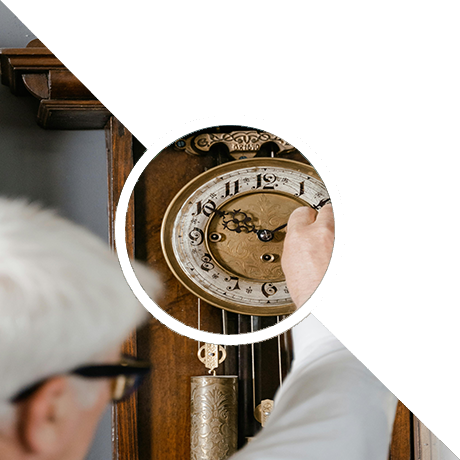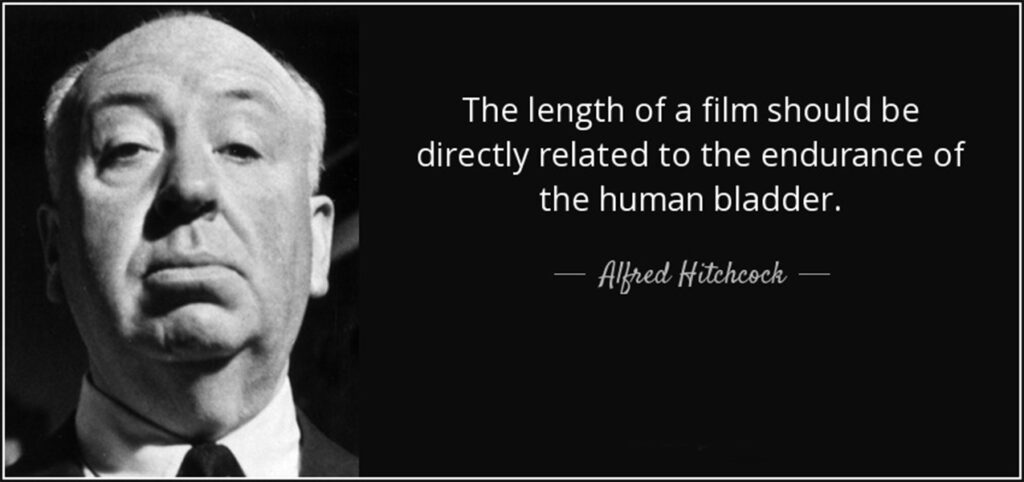
Timing is... every...th..ing
tick tock... tick tock... tick tock

If it’s too late, everyone’s forgotten.”


TIMING TO CONSIDER
Let’s look at timing in a variety of ways in our work.
In performance terms, long-form improvisers have a tendency to drag things out longer than they should.
Short-form improvisers often rush their timing, especially when they see a funny line on the horizon.
Improvisers tend not to take the time to work on timing because the content is never the same.
In business terms, the show you present might be out of sync with society. Did you know there’s a very narrow window where your edgy improvisation show will succeed? On either side of that window it might offend or bore your crowds. More about that in a moment.
Consider time as a quality you use to paint the emotional state of the audience. It’s the difference between staccato Mondrian image or a slow calm, Seurat seaside image.


SHOW TIMING
Let’s start with When and What to present – PRESENTATION TIMING. Is this the right show right now for this audience? Is this the right time of night? Is the show too long or short?
TOO SOON?
When you develop a new format, will it address touchy topical subjects? Will it straddle a point of political ‘correctness’? In scenes are you brave enough to handle delicate topics and if you are when is the best time to put scenes like that into the show? Those questions are often avoided until after a show where someone asks, why don’t we ever consider these things before we approach them on stage?
Professor Peter McGraw from Boulder Colorado did a study on the timing of “humerous/offensive” content in public perception over time. He presented a series of comically intended but potentially offensive twitter comments to participants about 2012 Hurricane Sandy. 10 groups of 100 participants rated humour/offensiveness in people’s comments. The groups were spread over time ranging from one day before the hurricane landed on shore with the last group being asked months after the event.
As expected, offense was registered at it’s highest to the comments in the first two weeks after the event. Peaking at about a month after the hurricane, there was dramatically less judgement about the comment’s and even a growing appreciation of the humour. Two months later, it appeared that the window of interest was in decline. By three months, attitudes about the comments had returned pretty much to the levels before the event occurred.
Topical content like environmental disasters, social calamities and, events like the 911 Trade Centre disaster have a moment of value in the content of presentation but the cathartic value lasts a fairly short time.. When and How to deliver a performance with questionable content is as much an art as the art of improvisation itself. If you want to do a topical show catch the wave of opportunity between 2 weeks and 3 months after the topic becomes relevant.
Timing the delivery of deeper issues in a show is a delicate thing. So the most offensive thing too early and you’ll likely lose your audience for the entire show. Approaching the content correctly calls for gently “inoculating” the audience with doses of the idea before delivering a full dose. In his article, “The Art and Science of Comedic Timing”, By Thomas MacMillan, he cites studies by Colorado professor Peter McGraw
…if you’re going to build a joke around a big violation, you need to invest enough time to make it benign. McGraw offered Louis C.K. as an example of a comedian who can get audiences to laugh at shocking, terrible things, because he knows how much to linger on benign qualifiers ahead of the violation, to make something very wrong feel very funny.
McGraw pointed to one of Louis C.K.’s “of course, but maybe” jokes, in which Louis C.K. says that while of course kids with deadly allergies should be protected from exposure to nuts, just maybe “if touching a nut kills you you’re supposed to die.” Louis C.K. spends over a minute setting up the context — he assures everyone that he really believes that dangerous foods absolutely must be kept away from vulnerable people — in order to present the idea that people should just let kids die so that it lands just right.
“I think that what Louis C.K. explicitly or implicitly knows is, if he’s going to say something on its own that would be terrifying, he needs to spend time to offset it,” McGraw said. The audience still feels like letting kids die is a shocking idea, which gives the joke its transgressive power, but Louis C.K. has put in the time to make it okay to laugh at that idea.
Humour or not, content will hit hardest when delivered WITHOUT leaking in the information too soon. When it comes to delicate issues, you will be more successful with small doses before you hit your major points. When you create a tilt that surprises and shocks the audience, you don’t want to leak in too much information , otherwise the audience sees it coming from a long way off and is less affected. In pathos and more serious work, let your topic surprise the audience to a point.
“I’m the one who hit your grandfather with the car.” has a stronger impact if we don’t know that the other character was out driving at the same time that you father was out walking and that you have a grandfather shaped bump in your car.
IS IT TIME?
The TIME of day that the show appears must be considered if you want to be successful. Midnight is not a great time for a kid’s show. 10 AM, Sunday morning will not likely connect to an alternate theatre audience looking for drinks and a reason to socialize. I remember trying something more poetic in a late-night show we were putting on around midnight. We switched our content from mime to mayhem and the crowds became easier to gather.
Is your audience coming from work? You’d better give them time to grab a bite and change into something more comfortable. Leave it too late and they won’t want to leave the sofa or they will have already left for another party. A half an hour in your timing can make a great difference.
A show in London couldn’t figure out what they were doing wrong when they consistently lost audience members during the second half of the show. It wasn’t until a cast member said they couldn’t perform in the show anymore because the last train home stopped running just before the show ended – too little time to catch transportation. Changing the time of the show made them instantly more popular. It had nothing to do with what they did. It was only about when they were doing it.
How long will the show run?
Current logic says that 75 minutes without an intermission or 90-110 minutes with an intermission is optimal for comedy. Attention spans for late-night audiences might be shorter. Formats that need time to develop characters and relationships might need more time. And if you are working with heavy material, give the audience a chance to breathe. A show that feels heavy for more than 10 minutes without some release can be torturous. If you focus on comedy, you will burn the audience out if they laugh too hard for too long. Pace yourself.

The second half of a show should typically be shorter. Pick up the pace as you approach the end. The audience should leave with beating hearts, not closed eyelids.
And remember, there is always an exception to the rule but it depends on the audience. Stay in sync with them and you are likely to have a good time with good timing.
TIMING OF SCENES
There was a consistent issue with the timing in a Keith Johnstone format called GORILLA at the Loose Moose Theatre in Calgary. 4 or 5 directors set up scenes that should aim at a variety of styles and time.
Scenes suffered from similar lengths in our shows. Most were a bit long. This had the impact of a predictable droning tone that gave the show undesired predictability and unintended weight. Keith suggested we give each director only 20 minutes for their scenes throughout the show. We could direct a couple of long scenes or a mix of longer and shorter ones. We discovered as we got short on time, we created more short scenes to balance the longer ones.
It worked. Most of the time. When it didn’t work, we realised we were relying on the 20-minute gimmick and not the reality of what the audience needed.
TIMING TIPS FOR SCENES AND SHOWS: Read the room
Consider What have you been doing? Then, Do something else. (That might sound stupid but too many people know something is wrong and what do they do? Nothing. They keep doing what hasn’t been working. Then they discuss it after the show and suggest… “We should have done something different.”
Some people have a bad sense of what the audience is experiencing. If that’s the case, simply switch up what you are doing. Any change in your timing and tone is ALMOST ALWAYS going to he better than hitting the same note for the same amount of time for the entire performance. Change content. Change timing.
CONTENT TIMING – delivering lines and looks.
As with everything… there are “rules” and then there is reality. The rules mustn’t trap you into a singular behaviour. When you have learned the impact of doing things ‘the right way’, play with doing it in other ways
- STOP MOVING – then say your line.
If you are always in motion when you speak, your lines have less impact and they create a sensation that time is moving faster for you AND for the audience. That’s not always a bad thing BUT it is an impact you should be aware of. - CONSIDER STATUS
High status people tend to deliver lines slower. It gives the content greater importance. The pacing of dialogue and physical movements are direct and specific. This conscious timing controls the audience and the scene. Too much of this feels contrived and boring. Nobody wants to be controlled for too long. - HEAR LIKE THE AUDIENCE HEARS.
If you talk through a scene without listening, you will speak faster. Your timing will be out of sync with how the audience is experiencing the moment. LISTEN TO YOUR PARTNER LIKE THE AUDIENCE LISTENS TO THEM. The timing of your reaction is dependent on you listening like an audience member. If your partner reveals something that changes your relationship the audience demands your reaction and then you can use your intellect. The difference in timing might be short or it might call for an immediate physical and emotional response with no words at all. - BEGIN SCENES WITH CONFIDENCE
Start scenes with confidence. Rush and you will burn the audience’s interest faster. “The audience will watch ANYTHING for 30 seconds if you are calm,” was one of Keith Johnstone’s common statements. The audience’s sense of time is secure when they feel that there is no threat. Performers who look anxious and rushed create a subliminal danger for the audience who will feel less patience or willingness to be with you in the moment. - EXPERIMENT WITH DIALOGUE DELIVERY
Most people’s timing tends to be hard wired. You deliver your content the way you do because it’s the way you’ve been doing it your entire life. Try performing characters that put their emphasis on unexpected places in their dialogue. You might find that your new timing unintentionally creates surprisingly different content.
Take this murder-revenge line as an example: “I AM GOING TO KILL YOU”.— I AM GOING… to kill you. (Misdirection – You say – “I am going…” You walk to the door and stop. As you turn back, you pull your gun and fire before leaving.)
— I … am going to kill you (You sound reluctant and didn’t want to say what you know you have to do)
— I am going to kill…. YOU. (This was the season finale of a “Walking dead.” episode where the villain had to make the choice of which hero had to die.) - ANTICIPATION
“AND THE WINNER IS-” Delayed delivery creates anticipation. We see it all the time in the announcement of contests. We also noticed that if it’s done too much, it’s predictably annoying. - PROMISES BUY YOU TIME.
Much like the anticipation suggestion above, timing is altered when the audience expects something. A promise in a scene has the impact of stopping time for the audience. When you do this, you can slow down confidently as long as all of your actions are obviously bringing the promise into reality. - FEAR DISTORTS YOUR TIMING
You feel a need to do SOMETHING NOW!!! So, you talk a lot and say nothing important. A few seconds can feel painfully long. There’s fear to fulfill promises. You feel you won’t have anywhere to go after you answer the big questions so you turn a simple answer into an entire chapter of filler. Fulfill the promise if the timing calls for it. Then, deal with the consequences. - THE PAUSE
Much has been said about placing pauses before lines of importance (Punch lines, etc). Numerous studies shows that this isn’t necessarily true. IF you are interested you might want to read this exhaustive study:
A study of timing in comedy… HERE!
Some key findings are:
– Punch lines are not produced at a different rate of speech than the baseline.
– The hypothesis that punch lines are preceded by an emphatic pause is rejected. Very few punch lines were preceded by a noticeable pause at all.
– There appears to be no significant difference in any of the above features in relation to a prepared joke and an improvised joke.
- IF you need a visual representation of comedy timing… Perhaps Borat might assist: HERE!

EMOTIONAL TIMING
Scenes die certain death without emotional change. Control-issues hold performers hostage inside emotional states. Watch argumentative characters played by newer improvisers. Their ego becomes invested in the character’s battle. Unwilling to lose, or be altered by their partner, they will carry on the battle with the other character longer than the audience is interested in the actual content of the argument.
At some point, the audience wants to see something happen. Whether the villain wins or the hero does is irrelevant (TO A POINT). Someone be changed!
The audience loses interest in two immovable positions being thrown back and forth with the characters. Love scenes can be touching but they can drag on with characters unwilling to leave the cozy feeling.
Keep some sense of timing active when you enter emotional states on stage. If each character has carried the dialogue 2 or 3 times, be altered. Have an emotional change. If you are watching off stage, use your perspective to help the performers on stage move the scene into the next phase of the story.
DID YOU KNOW?
A neurological condition called “Tachypsychia” distorts some people’s perception of time. Consider a dangerous situation or stressful moment you were in where “time stopped” or vanished altogether. That experience is similar. In theatre, if we give an audience an emotional experience we can make “time fly” or a moment “last a lifetime”. It’s kind of fun to think that that the theatre is a time travel machine that transports people to other times speed time up or slows it down.
TIME’S UP
There are obviously many tips and tricks to timing as there are many aspects to look at but I’ve already gone over my time …
Remember, no rules work all the time. Be flexible with what you discover.
Check out some of these sources. Play with some of them if you have time.
The Art and Science of Comedic Timing | Thomas MacMillan
What makes things funny | Peter McGraw
Timing in the performance of jokes | SALVATORE ATTARDO and Lucy Pickering
Comedic Timing 101: How to Tell Jokes With Ease | LEAH MARILLA THOMAS
Why the Days Seem Shorter as We Get Older | Adrian Bejan
All in the Timing |JEAN SCHIFFMAN
